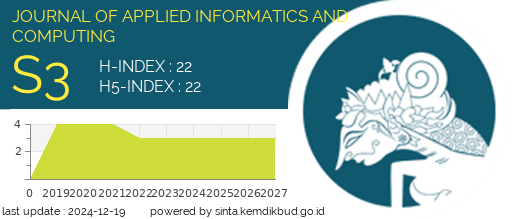Implementation of Fisher-Yates Shuffle and Fuzzy Tsukamoto in Nusantara Educational Game
DOI:
https://doi.org/10.30871/jaic.v9i2.9248Keywords:
Education Game, Fisher-Yates Shuflle Algorithm, Fuzzy Tsukamoto Algorithm, Mobile Android GameAbstract
This research introduces "PINUS: Petualangan Ilmu Nusantara," an educational game designed to improve players' knowledge and interest in Indonesian culture, flora, fauna, and national figures. The game incorporates the Fisher-Yates Shuffle algorithm to randomize questions and answers, ensuring variety, and the Fuzzy Tsukamoto algorithm to calculate scores based on player performance for fair and competitive assessment. Quantitative methods were employed, with data collected through interviews, literature reviews, and system testing via alpha testing (black- box) and beta testing (user acceptance testing or UAT). The One Group Pretest- Posttest Design method was also applied. The findings show that the Fisher-Yates Shuffle enhances challenge and engagement, while the Fuzzy Tsukamoto algorithm ensures balanced scoring, fostering motivation. UAT results indicate strong functional acceptance, with an average score of 84.9% ("Strongly Agree"). The pre- test and post-test analysis revealed a score improvement average of 0.307, categorized as moderate. These findings affirm PINUS effectiveness in enhancing learning comprehension by offering interactive features, educational content, and dynamic question variations. The game provides an engaging, accessible, and technology-driven learning medium, making it a valuable tool for supporting educational initiatives.
Downloads
References
[1] M. Hetu Marsella, P. Adhitya, and D. Putra, “ICESE Interaction, Community Engagement, and Social Environment ICESE 1(2): 94-107 Analysis of independent city concept in reclamation area PIK 1 & PIK 2 based on community, government, and private sector role,” ICESE, vol. 1, no. 2, pp. 94–107, 2024, doi: 10.61511/icese.v1i2.
[2] A. Mulyanto and P. Prasetyawan, “Rancang Bangun Game Edukasi ‘Matching Aksara Lampung’ Berbasis Smartphone Android,” CESS, vol. 3, no. 1, pp. 2502–714, Jan. 2018.
[3] A. S. Pratama, R. A. Krisdiawan, and Y. Yulyanto, “Implementasi Algoritma Fisher Yates Suffle Pada Game Things Bedroom,” Digital Transformation Technology, vol. 4, no. 1, pp. 196–205, May 2024, doi: 10.47709/digitech.v4i1.3753.
[4] D. Setiawan, “Jurnal Pendidikan Ilmu-Ilmu Sosial Kontribusi Tingkat Pemahaman Konsepsi Wawasan Nusantara terhadap Sikap Nasionalisme dan Karakter Kebangsaan,” Jurnal Pendidikan Ilmu-Ilmu Sosial, vol. 9, no. 1, pp. 24–33, Jun. 2017, doi: https://doi.org/10.24114/jupiis.v9i1.6457.
[5] K. V. W. Atmaja, I. P. Sriartha, and I. W. Kertih, “Metode Role Playing Berbasis Billingual untuk Meningkatkan Kemampuan dan Hasil Belajar Siswa SMP Laboratorium Undiksha,” Media Komunikasi FPIPS, vol. 22, no. 1, pp. 24–36, Apr. 2023, doi: 10.23887/mkfis.v22i1.50982.
[6] V. Asih, A. Saputra, and R. T. Subagio, “Penerapan Algoritma Fisher Yates Shuffle Untuk Aplikasi Ujian Berbasis Android,” JURNAL DIGIT, vol. 10, no. 1, pp. 59–70, May 2020, doi: https://doi.org/10.51920/jd.v10i1.156.
[7] K. Nurfitri, I. Abdurrozzaq, and J. Karaman, “Penerapan Algoritma Fisher Yates Shuffle pada Game Edukasi ‘English For Children’ di LKP Elite English School Ponorogo,” Digital Transformation Technology, vol. 3, no. 2, pp. 438–449, Sep. 2023, doi: 10.47709/digitech.v3i2.2885.
[8] A. H. Annazili and A. Qoiriah, “Implementasi Algoritma Fisher-Yates Shuffle Dan Fuzzy Tsukamoto Pada Game Petualangan Si Thole Berbasis Android Menggunakan Game Engine Unity,” JINACS, vol. 01, no. 04, pp. 188–199, 2020, doi: https://doi.org/10.26740/jinacs.v1n04.p188-199.
[9] F. Try and S. Utomo, “Inovasi Media Pembelajaran Interaktif Untuk Meningkatkan Efektivitas Pembelajaran Era Digital Di Sekolah Dasar,” Jurnal Ilmiah Pendidikan Dasar, vol. 8, pp. 3635–3645, Sep. 2023, doi: https://doi.org/10.23969/jp.v8i2.10066.
[10] M. W. Magister, “Pendekatan Penelitian Pendidikan: Metode Penelitian Kualitatif, Metode Penelitian Kuantitatif dan Metode Penelitian Kombinasi (Mixed Method),” Jurnal Pendidikan Tambusai, vol. 7, pp. 2896–2910, 2023.
[11] D. M. Santika, F. Fauziah, and B. Rahman, “Algoritma Fisher Yates Pada Aplikasi Pembelajaran Teknik Pengambilan Gambar Menggunakan Kamera DSLR Berbasis Android,” Journal of Computer System and Informatics (JoSYC), vol. 4, no. 4, pp. 789–796, Aug. 2023, doi: 10.47065/josyc.v4i4.3867.
[12] I. Gede Bagastia Widi Atmaja, K. Ngurah Adi Kusuma, A. Agung Eka Wirayuda, I. Komang Widiantara, N. Premadhipa, and G. Surya Mahendra, “Penerapan Metode Prototype pada Perancangan Sistem Informasi Pengaduan Masyarakat Buleleng Berbasis Website,” RESI, 2023.
[13] Kurniati, “Penerapan Metode Prototype Pada Perancangan Sistem,” Journal of Software Engineering Ampera, vol. 2, no. 1, pp. 2775–2488, Feb. 2021, [Online]. Available: https://journal-computing.org/index.php/journal-sea/index
[14] R. Ganesh and G. Prabu, “Determination of Internet Banking Usage and Purpose with Explanation of Data Flow Diagram and Use Case Diagram,” International Journal of Management and Humanities (IJMH), vol. 4, no. 7, pp. 52–58, Mar. 2020, doi: 10.35940/ijmh.G0674.034720.
[15] R. Hafsari, E. Aribe, and N. Maulana, “Perancangan Sistem Informasi Manajemen Inventori Dan Penjualan Pada Perusahaan Pt. Inhutani V,” PROSISKO, vol. 10, no. 2, pp. 109–116, Sep. 2023, doi: https://doi.org/10.30656/prosisko.v10i2.7001.
[16] D. Mirwansyah, K. A. Zahro, and M. Irfan, “Perancangan Sistem Informasi Monitoring Akademik Dengan Menggunakan Data Flow Diagram,” LOCUS, vol. 2, no. 12, pp. 1201–1207, Dec. 2023, doi: https://doi.org/10.58344/locus.v2i12.2352.
[17] B. Solikhin and A. Rifal, “Sistem Informasi Pengolahan Data Laporan Kasus Kriminal Pada Subdit Renakta Ditreskrimum Polda Jawa Timur,” Dike, vol. 1, no. 2, pp. 17–23, Aug. 2023, doi: https://doi.org/10.69688/dike.v2i1.64.
Downloads
Published
How to Cite
Issue
Section
License
Copyright (c) 2025 Khairul Insan Karim, Chairunnisa Lamasitudju, Ryfial Azhar, Fizar Syafaat, Anisa Yulandari

This work is licensed under a Creative Commons Attribution-ShareAlike 4.0 International License.
Authors who publish with this journal agree to the following terms:
- Authors retain copyright and grant the journal right of first publication with the work simultaneously licensed under a Creative Commons Attribution License (Attribution-ShareAlike 4.0 International (CC BY-SA 4.0) ) that allows others to share the work with an acknowledgement of the work's authorship and initial publication in this journal.
- Authors are able to enter into separate, additional contractual arrangements for the non-exclusive distribution of the journal's published version of the work (e.g., post it to an institutional repository or publish it in a book), with an acknowledgement of its initial publication in this journal.
- Authors are permitted and encouraged to post their work online (e.g., in institutional repositories or on their website) prior to and during the submission process, as it can lead to productive exchanges, as well as earlier and greater citation of published work (See The Effect of Open Access).











